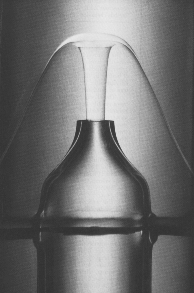
1.
Meissner Effect
As described before,
superconductors create a perfect diamagnet under a magnetic
field. The difference between the interactions of the magnetic
field lines for a normal conducting state and superconducting
state are shown in the figure below. The lines that indicate
the magnetic field lines on the right object in the figure are
spaced differently for different materials. How much the
magnetic field lines bend and space around the superconducting
material has to do with the London penetration depth. The
London penetration depth is related to the magnetic field
strength of the superconducting surface by a factor. This
expulsive property of superconductors has applications in very
efficient magnetically levitated trains and magnetic resonance
imaging, since this allows for little energy loss through
frictional forces.

Source:
http://global-sei.com/super/about_e/feature.html
2.
Zero Electrical Resistance
There are a few aspects
that cause the zero resistance. As electrons move through the
material, and assuming the material is at the critical
temperature, the electrons will cause atoms in the lattice to
pull inward. The change of shape of the lattice pulls the
trailing electrons. This constant pull of the electrons allows
the electrons to pass through the material with relative ease.
One particular application for this effect is the ability to
make very fast acting switches. Much like a capacitor, two
superconductors can be tied together with an insulator between
them. When a current is applied to the material, the zero
electrical resistance allows the electrons to transfer nearly
instantly; this effect is called the Josephson Effect.

3.
Superfluidity
Superfluidity is a
phenomenon that has been used to study superconductivity.
Superfluidity occurs when helium is cooled to its critical
temperature. At this state, the superfluid has zero viscosity,
causing the material to flow seamlessly and have a very high
heat capacity. This low heat capacity allows the superfluid to
act as an amazing refrigerant, as Onnes had used in
discovering superconductors. It also has the ability to climb
the up the inside of containers, and under light will flow out
any openings in the container the superfluid is in; both of
these phenomenons are caused by the zero viscosity. The effect
if flowing out of a container is shown in the image below:

Source:
http://www.nature.com/physics/highlights/6919-2.html
--------------------------------------------------------------------------------------------
Previous - Home - Next